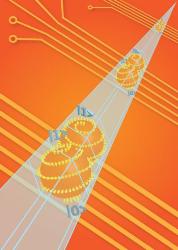Dec 24 2010
Scientists from the Kavli Institute of Nanoscience at Delft University of Technology and Eindhoven University of Technology in The Netherlands have succeeded in controlling the building blocks of a future super-fast quantum computer.
They are now able to manipulate these building blocks (qubits) with electrical rather than magnetic fields, as has been the common practice up till now. They have also been able to embed these qubits into semiconductor nanowires. The scientists' findings have been published in the current issue of the science journal Nature (23 December).
 This is an artist's impression of nanowire qubits.
This is an artist's impression of nanowire qubits.
Spin
A qubit is the building block of a possible, future quantum computer, which would far outstrip current computers in terms of speed. One way to make a qubit is to trap a single electron in semiconductor material. A qubit can, just like a normal computer bit, adopt the states '0' and '1'. This is achieved by using the spin of an electron, which is generated by spinning the electron on its axis. The electron can spin in two directions (representing the '0' state and the '1' state).
Electrical instead of magnetic
Until now, the spin of an electron has been controlled by magnetic fields. However, these field are extremely difficult to generate on a chip. The electron spin in the qubits that are currently being generated by the Dutch scientists can be controlled by a charge or an electric field, rather than by magnetic fields. This form of control has major advantages, as Leo Kouwenhoven, scientist at the Kavli Institute of Nanoscience at TU Delft, points out: 'These spin-orbit qubits combine the best of both worlds. They employ the advantages of both electronic control and information storage in the electron spin.'
Nanowires
There is another important new development in the Dutch research: the scientists have been able to embed the qubits (two) into nanowires made of a semiconductor material (indium arsenide). These wires are of the order of nanometres in diameter and micrometres in length. Kouwenhoven: 'These nanowires are being increasingly used as convenient building blocks in nanoelectronics. Nanowires are an excellent platform for quantum information processing, among other applications.'
Source: http://www.english.tudelft.nl/